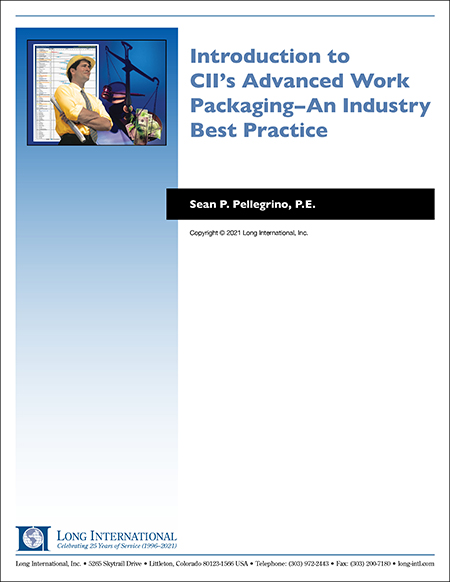
Introduction to CII’s Advanced Work Packaging – An Industry Best Practice
This article discusses the Construction Industry Institute (CII) Advanced Work Packaging (AWP) process.
1. INTRODUCTION
Imagine how successful construction or fabrication project execution could be if there were a structured and disciplined process that required a purposeful “start early,” “keep the end in mind,” and interactive communication, collaboration and alignment with all associated project disciplines and parties during planning and execution of the project. This process does exist: welcome to the Construction Industry Institute (CII) Advanced Work Packaging (AWP) process.
AWP was developed through a collaboration between the Construction Owners Association of Alberta (COAA) and CII.1 The information presented in this article is a summary introduction to AWP. The summary introduction follows the work compiled by the CII Research Team (RT) 272, Advanced Work Packaging: Design through Workface Execution.2, 3 This author was heavily involved with RT 272 and has received approval from CII to summarize its findings in this article.4
In September 2015, CII recognized AWP as a CII Best Practice. As defined by CII, “A CII Best Practice is a process or method that, when executed effectively, leads to enhanced project performance. CII Best Practices have been proven through extensive industry use and/or validation.” Validation for the CII Best Practice recognition was obtained through analysis performed by CII RT 319, Transforming the Industry: Making the Case for Advanced Work Packaging as a Standard (Best) Practice.
CII defines AWP as follows:
Advanced Work Packaging is the overall process flow of all the detailed work packages (construction, engineering, and installation work packages). AWP is a planned, executable process that encompasses the work on an EPC project, beginning with initial planning and continuing through detailed design and construction execution.; AWP provides the framework for productive and progressive construction, and presumes the existence of a construction execution plan.5
The AWP process strategically breaks down the construction scope into distinct and manageable packages. The AWP process commences in early engineering and cascades through the project life cycle to provide the construction team the ultimate and eventual deliverable, the Installation Work Packages (IWP). Each IWP is designed to identify and provide a single discipline crew (e.g., civil, structural, piping, mechanical, electrical, and instrumentation) all the constraint free requirements necessary to safely and efficiently commence and complete the defined work scope.
It is clearly to be noted that AWP methodology is used to supplement established good project management planning and execution practices. AWP may not lead to successful project results if established good project management planning and execution practices are not adhered to and applied appropriately.
2. BUSINESS CASE
Projects are expected to continue increasing in size and complexity. A significant amount of project failures continue to occur. Especially on larger projects such as megaprojects (i.e., projects costing more than US$1 billion), the frequency of project failures is alarming. According to Independent Project Analysis (IPA) Founder and CEO Edward Merrow, four out of every five oil and gas megaprojects that IPA studied were characterized as failures.6 Additionally, it was further commented by IPA that even in other project sectors (including minerals, chemicals, and power), projects were categorized by a failure rate of approximately 50%.7 Smaller projects are not immune to alarmingly high project failures related to meeting their objectives. Citing an example for smaller project failures, an IPA study found that over one-third of all site-based projects studied failed to meet objectives.8 These small site-based projects are characterized as projects costing less than US$10 million.
Owner and construction organizations that execute projects require project management processes to help ensure profitable and predictable project performance. If implemented correctly, AWP can be an additional process in an owner or contractor’s project management process arsenal to improve project delivery effectiveness and predictability. The deliberate engineering and construction management practices recommended in AWP are keys to improving craft labor productivity and construction predictability. AWP helps to drive earlier and more collaborative planning on projects.
A slight improvement in craft labor productivity during construction can have a positive incremental impact on a project’s profitability. The larger the project, the more expected value there is in using AWP. Inherent in the discussion of profitability is also the need for better project performance predictability. The CII AWP process has been shown to enhance project performance in these two areas.
As the CII case studies have shown, the CII AWP process, if correctly implemented through the project life cycle, improves field productivity and the predictability of key schedule and cost project metrics. Residual benefits of improved field safety, site cleanliness, better quality, and higher project team morale were also reported when AWP was followed.
A recommended practice in the AWP process is to utilize discipline-specific workface planners in the development, preparation and control of the work packages. This workface planner resource takes away a significant amount of the routine office work from the field foreman, allowing for more field availability. This removal of work from the foreman’s scope allows the foremen to do what they do best in supporting the work by spending more time in the field. Intuitively, and backed by studies, increased foreman field availability can increase safety, quality and productivity during construction.9
With a deliberate and disciplined implementation of AWP processes, the CII RT 319 and RT 272’s case studies, as well as the experience of others (e.g., member companies of COAA), report that AWP benefits can be significant. It has been reported that a few of the case-studied projects, when compared to similar projects without implementation of AWP principles, experienced up to a 25 percent reduction in schedule duration and a four to ten percent reduction in Total Installed Cost (TIC).
Benefits reported in the CII case studies were:
- Improved safety awareness and performance;
- Reduced cost through improved labor productivity and reduced rework;
- Improved overall project predictability for cost and schedule;
- Improved up-front planning;
- Better alignment among stakeholders from planning through construction;
- Better than normal craft retention due to improved morale;
- Improved foreman field time availability;
- Improved housekeeping/site cleanliness;
- Improved quality of progress tracking;
- Improved installation quality; and
- Enhanced turnover to Operations.
These positive results can vary in degree. Even when implementing the AWP process, these results can be influenced by the utilization of project management processes, resource availability and skills, and the organizational capabilities of the parties. The benefits noted have been recognized on both larger and smaller projects. To maximum the benefits from AWP, the project team should execute AWP by starting the process early during project definition, extending into the planning and engineering phases, and continuing through construction.
When the AWP process is successfully implemented, the benefits of AWP can significantly outweigh the cost to implement.
3. AWP PROCESS
AWP is a deliberate and disciplined integrated approach for improving project performance and predictability through the project life cycle. The AWP process supplements normal good project management planning and execution practices. The focus of the AWP process is to identify recommended execution activities, engineering through to construction, that deliver constraint free executable Installation Work Packages (IWPs) that align with the sequence of construction.
The AWP process incorporates the full project life cycle, commencing in early project setup and continuing with activities through to project start-up and turnover, as shown in Figure 1 below. The success of AWP is highly dependent on the alignment and coordination between the project’s owner, contractors, and their various discipline leads involved in the planning, engineering, project controls and execution of the work scope, down to the work front.
The early interactive project planning establishes the necessary coordination between the engineering, construction, and system turnover teams for the development of Engineering Work Packages (EWPs) and Construction Work Packages (CWPs). These packages are matured and broken into Installation Work Packages (IWPs) through deliberate and disciplined planning and execution. Management of the IWPs in the field is commonly referred to Workface Planning (WFP).10
Figure 1
Conceptual View of Advanced Work Packaging within the Project Life Cycle
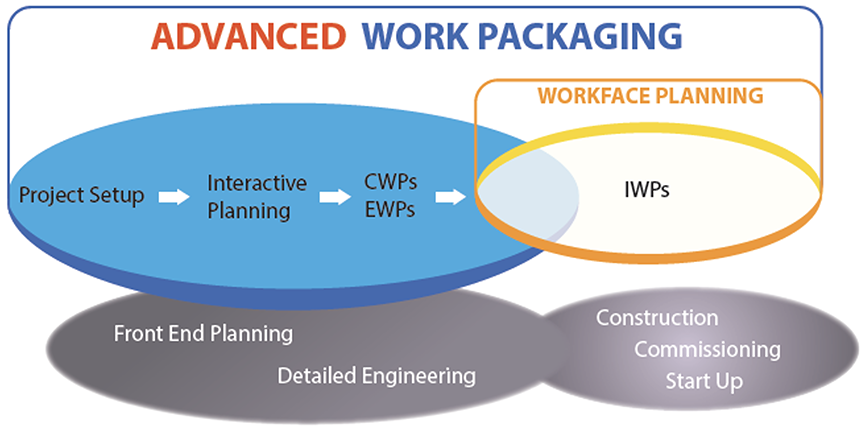
From CII “Advanced Work Packaging: Design Workface Execution,” Implementation Resource 272-2 Version 3.1, Vol. 1 (October 2013).
3.1 KEY TERMS
It is important to understand a few key terms11 to add clarity to Figure 1 and the AWP process. Some of the key terms and their package contents are:
Constraints: Any prerequisite item, including and not limited to work access, prior work to be complete, tools, resources, permits, materials and equipment that prevents and/or delays the successful execution of the work.
Construction Work Area (CWA): A portion of the plot plan that has been defined by construction as being a logical area of work. The CWA includes all of the disciplines.
Construction Work Package (CWP): An executable construction deliverable that defines in detail a specific scope of work in a particular Construction Work Area (CWA). It should include a budget and schedule with monitoring of actual performance. The scope of work is such that it does not overlap another CWP. (Some CWPs are identified and broken down by the specific contractor performing the work).
A typical CWP may contain:
- CWP boundary defined;
- Schedule for work to be performed;
- Related EWPs to CWP (at least one EWP to CWP);
- Budget (man-hours/cost);
- Health, Safety and Environmental requirements;
- Quality requirements; and
- Resource requirements.
Engineering Work Package (EWP): An engineering deliverable that is used to develop a Construction Work Package (CWP) and defines the scope of work to support construction in the form of drawings, procurement deliverables, specifications, and vendor support. The EWP is released in an approved sequence that is consistent with the CWP schedule.
A typical EWP may contain:
- EWP relationship to a specific CWP;
- Scope of work defined;
- Schedule of work to be performed;
- Document list required for the scope of work;
- Drawings identified for the scope (e.g., plot plan, general arrangement);
- Installation and materials specifications for the scope;
- Vendor data for the scope;
- Line and equipment lists for the scope; and
- Any additional information or studies needed to support the scope.
Installation Work Package (IWP): A detailed execution plan that ensures all elements necessary to complete the installation of a particular scope of work in the field are organized and delivered before work is started. An IWP enables craft persons to perform quality work for the specific scope in a safe, effective, and efficient manner. Generally, the scope of work associated with the IWP is small enough that it could be completed by a single-foreman crew, typically in a one- or two-week time frame. (A generally recommended size of an IWP is 500 to 1,000 man-hours, or approximately one to two weeks of work for one crew).
A typical IWP may contain:
- Summary of the installation work package scope, including:
- Description of the work
- Facility Code (code reference) for the IWP
- Cost Code/WBS Code for the IWP
- IWP originator and contact information
- Work steps and sequence of the IWP
- Reference to required documents for the IWP
- Estimated labor hours to complete the IWP
- Estimated quantities to be installed
- Required witness or hold points
- Special Instructions
- Safety Hazard Analysis covering IWP work activities;
- Material Safety Data Sheet;
- Required drawings for installation (isos/engineering/vendor);
- 3D model shots (if available);
- Bill of Materials/Equipment Lists/Line Lists for IWP;
- Relevant specifications reference to complete work;
- Quantity work sheet;
- Required/special tools and equipment for IWP;
- Deviation Notices (e.g., non-conformance report, design change notice, field change request);
- Inspection Check sheets;
- As-built documentation; and
- Verification signatures of completion of work.
Workface Planner: The Workface Planner is responsible for the conversion of Construction Work Packages (CWP) into Installation Work Packages (IWP), as well as insuring that all necessary resources are available and constraints are removed prior to releasing the IWP to the field.
A Workface Planner participates in front-end planning and ensures continuity and integration of the work packaging structure between phases. He or she is to provide the essential coordination among engineering, procurement, and construction. The Workface Planner’s goal is to ensure the timely issuance of complete and constructible Installation Work Packages (IWP) that support, and are in line with, the construction schedule.
Workface Planning (WFP): The process of organizing and delivering all of the elements necessary before work is started, to enable craft persons to perform quality work in a safe, effective, and efficient manner.
3.2 AWP PROCESS OVERVIEW
An overview of the CII-recommended AWP process is graphically presented in Figure 2 below. The AWP process incorporates a full project life cycle approach to maximize the project execution benefits. The AWP process will be explained by the three stages as developed by CII Research Team 272 and summarized as outlined in CII’s Advanced Work Packaging: Design through Workface Execution publication in October 2013. The project life cycle stages are defined generically to highlight generally accepted stage divisions.
The AWP process covers the activities from project definition through system turnover/start-up and commissioning. Each of the stages is to build upon activities completed from the previous stage. Stage I, Preliminary Planning/Design, incorporates activities necessary for work packaging. Stage II, Detailed Engineering, builds off the plans from Stage I. Stage II supports the development of the sequence of construction (i.e., the path of construction), aligning engineering deliverables with construction requirements. In Stage III, Construction bears fruit in the form of IWPs from the detailed planning and coordination in the previous stages.
Figure 2
Integrated Advanced Work Packaging Flow Chart

From: CII “Advanced Work Packaging: Design Workface Execution,” Implementation Resource 272-2 Version 3.1, Vol. 1 (October 2013)
3.2.1 Stage I – Preliminary Planning/Design
Stage I, Preliminary Planning/Design, supports generally accepted project management practices for this phase. The exception to these generally accepted practices is the inclusion of activities for work packaging in this phase. Critical work packaging activities in this stage include consideration for the construction sequence (i.e., the path of construction). This stage requires the coordinated planning of engineering to support the construction and system turnover sequence. Early identification of the CWP and the respective EWP boundaries is required. This coordination of engineering, construction and system turnover leads to the early development of CWPs and EWPs.
A critical factor for success in this stage is having the appropriate engineering, construction, system turnover, and vendor expertise made available for planning input. As better information becomes available and more detailed work is performed, these preliminary planning/design stage deliverables are to mature throughout the life cycle.
The key Stage I, Preliminary Planning/Design, recommended AWP activities are shown in Figure 3 and discussed further below.
Figure 3
Stage I – Preliminary Planning/Design
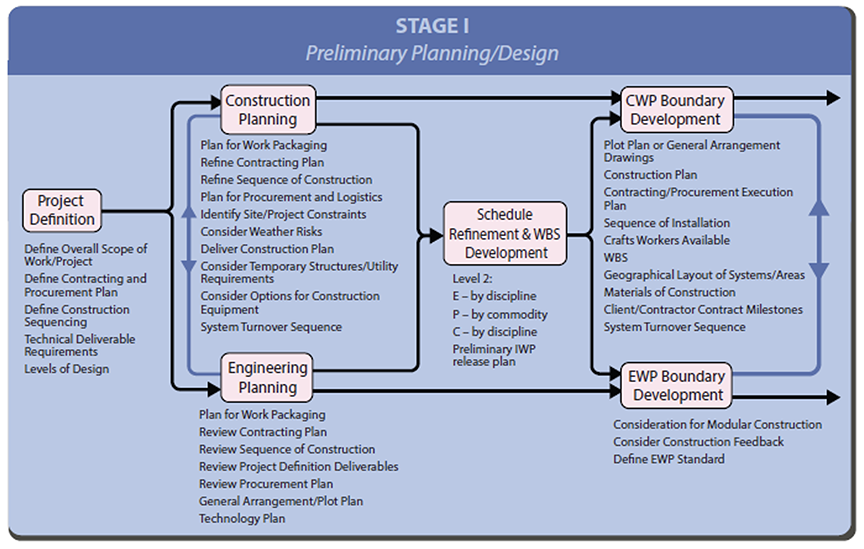
From: CII “Advanced Work Packaging: Design Workface Execution,” Implementation Resource 272-2 Version 3.1, Vol. 1 (October 2013)
3.2.1.1 Stage I – Project Definition
Two key objectives of project definition are to align stakeholders on the total project perspective, and to identify drivers to maximize the benefits of work packaging during construction. The project definition is to define the preliminary construction plan for AWP. The identified activities involved in project definition are:
- Define overall scope of work/project;
- Define contracting and procurement plans;
- Define construction sequencing – establish how the facility is to be constructed (e.g., stick build, modular); and
- Establish technical/engineering deliverable requirements and the level of design detail – deliverables and details that align with construction sequencing requirements.
3.2.1.2 Stage I – Construction Planning
A key objective in this stage is to identify the key construction planning activities and construction requirements for effective work packaging.
The identified activities involved in construction planning are:
- Plan for work packaging;
- Refine contracting plan;
- Refine sequence of construction/path of construction;
- Plan for procurement and logistics requirements;
- Identify site/project constraints;
- Consider weather risks and potential mitigations;
- Develop construction plan details – establish a construction execution plan
- Consider temporary structures/utility requirements – establish parking, traffic flow, offices, lay down areas and other necessary temporary and utility requirements;
- Consider options for construction equipment – review how the equipment is to be utilized to increase effectiveness; and
- Develop system turnover sequence.
3.2.1.3 Stage I – Engineering Planning
A key objective in this stage is the early collaboration and alignment between engineering, construction and system turnover planning. It is important to identify the anticipated key constraints during execution and address them in the planning. The ultimate outcome is matching the timing of the engineering deliverables with the construction and system completion sequences, as agreed by all involved parties.
The identified activities involved in engineering planning are:
- Plan for work packaging;
- Review contracting plan;
- Review sequence of construction;
- Review project definition deliverables;
- Review procurement plan;
- Develop general arrangement/plot plan; and
- Establish a technology plan, to address data format and tagging requirements to be used throughout the project.
3.2.1.4 Stage I – Schedule Refinement and WBS Development
Key objectives in this stage are the development of the initial Level 2 schedule and the development of the project’s Work Breakdown Structure (WBS). Involvement and review from engineering, project controls, construction and system turnover is important to ensure alignment between the schedule and the WBS. These deliverables are the result of incorporating input from the previous process activities.
The identified activities involved in schedule refinement, which is to be aligned with the WBS development, are:
- Develop an initial Level 2 schedule – detailed by engineering discipline, procurement commodity, and construction discipline; and
- Develop an initial IWP release plan – by CWP, which establishes an initial estimate of the number of IWPs.
3.2.1.5 Stage I – CWP Boundary Development
Key objectives in this stage are the further maturing and breakdown of the scope of work into appropriate CWPs, and determining how the CWPs will be executed. This CWP breakdown considers the anticipated contracting strategy and logical geographical limits. The size of the CWP is reported in terms of the man-hours required to execute the work. The CWP identification and sizing must consider the appropriate ability to plan, organize, execute and control the work. The ultimate objective for the CWP breakdown is to further mature and develop the detailed IWPs. The CWP breakdowns should also align with the WBS.
The identified activities involved in CWP boundary development are:
- Mature plot plan or general arrangement drawings to identify the CWPs;
- Mature construction plan for CWP alignment;
- Mature contracting/procurement/execution plans for CWP alignment;
- Mature sequence of installation for CWP sequencing;
- Assess craft workers availability by CWP to ensure appropriate resource leveling;
- Refine WBS to ensure CWP alignment;
- Establish geographical layout of systems/areas to identify interfaces between construction and system completion;
- Identify materials of construction to identify unique and long lead material that may impact CWP sequencing;
- Establish client/contractor contract milestones to identify milestones to align with CWP sequencing; and
- Mature system turnover sequence for consideration in CWP sequencing.
3.2.1.6 Stage I – EWP Boundary Development
A key objective in this stage is the further maturing and separation of the engineering and procurement deliverables to support both logical engineering workflows and construction sequencing. The ultimate objective is to establish EWPs that align with their respective CWPs and that can be efficiently performed. Therefore, close coordination between the EWP and CWP boundary development is paramount.
The results from the EWP boundary development support the identification of the engineering deliverables for detailed design execution.
The identified activities involved in EWP boundary development are:
- Consider if fabrication will be performed using modular construction. The fabrication method will impact EWP deliverables.
- Consider construction feedback prior to the start of detail engineering to minimize rework.
- Define EWP Standard for controlling EWP creation and completion to ensure alignment with the WBS.
3.2.2 Stage II – Detail Engineering
Stage II, Detail Engineering, in the AWP process results in the development of the Level 3 schedule. This result is accomplished by the purposeful interactive coordination between engineering and the Level 3 schedule development. The work in this stage matures and refines the work packaging activities performed in Stage 1 of the AWP process.
The Stage II, Detailed Engineering, recommended AWP activities are shown in Figure 4 and discussed further below.
Figure 4
Stage II – Detail Engineering
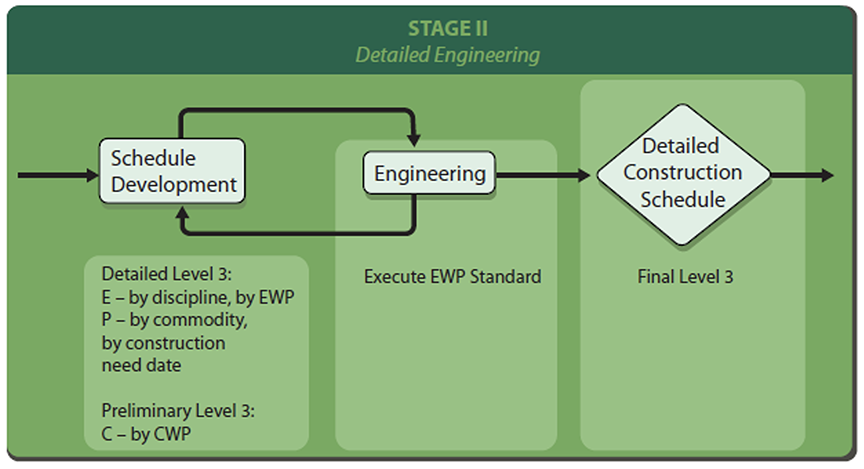
From: CII “Advanced Work Packaging: Design Workface Execution,” Implementation Resource 272-2 Version 3.1, Vol. 1 (October 2013)
3.2.2.1 Stage II – Schedule Development
A key objective in this stage is to detail the schedule, resulting in a preliminary Level 3 schedule by CWP. This schedule detailing is to be performed by the respective engineering disciplines per EWP, with procurement activities by commodity. All of this schedule information is tied to the required dates in the established construction sequence.
For success, the appropriate engineering, procurement and construction experts should participate to support the detailing of the Level 3 schedule.
3.2.2.2 Stage II – Engineering
A key objective in this stage is to identify and develop the necessary design engineering documents to support the execution of the EWPs and CWPs.
3.2.2.3 Stage II – Detailed Construction Schedule
A key objective in this stage is to finalize the detailed construction schedule in the Level 3 schedule.
3.2.3 Stage III – Construction
Stage III, Construction, is where the rubber meets the road and all the previous AWP process efforts come to fruition. A goal of AWP is to produce constraint free IWPs that support the construction sequence and thus the schedule. It is here at the IWP level where the project can reap the majority of the reported benefits of AWP. An effective IWP is all about ensuring that the right work is performed at the right time, and that all of the necessary elements to safely complete the work have been identified and are available prior to the start of that specific work package.
A key resource in this stage is the Workface Planner. The Workface Planning team consists of the discipline-specific Workface Planners, who provide cradle through grave IWP planning and execution support. Their responsibilities include the creation, monitoring and clearing of constraints, issuance, field execution and closeout of the IWPs.
The focus of this stage is on the IWP execution and the full IWP Life Cycle. The IWP Life Cycle process is important to drive and sustain the necessary communication, constraint management/validation and documentation required by the ultimate client, the crew at the workface. The IWP Life Cycle process has been broken into five steps and detailed in the following five flow charts:
- IWP Creation;
- Document Control Interface;
- Issuance of IWP to the Field;
- Control of the IWP in the Field; and
- IWP Closeout.
An overview of IWP Life Cycle process is shown in Figure 5. Each of the five blocks identifies the key elements and the interfaces of the overall IWP Life Cycle. As a picture is worth a thousand words, each of the five steps in the IWP Life Cycle process will be explained through the CII‑developed flow charts.
Figure 5
Stage III – Construction: Overview of IWP Life Cycle Flow Charts
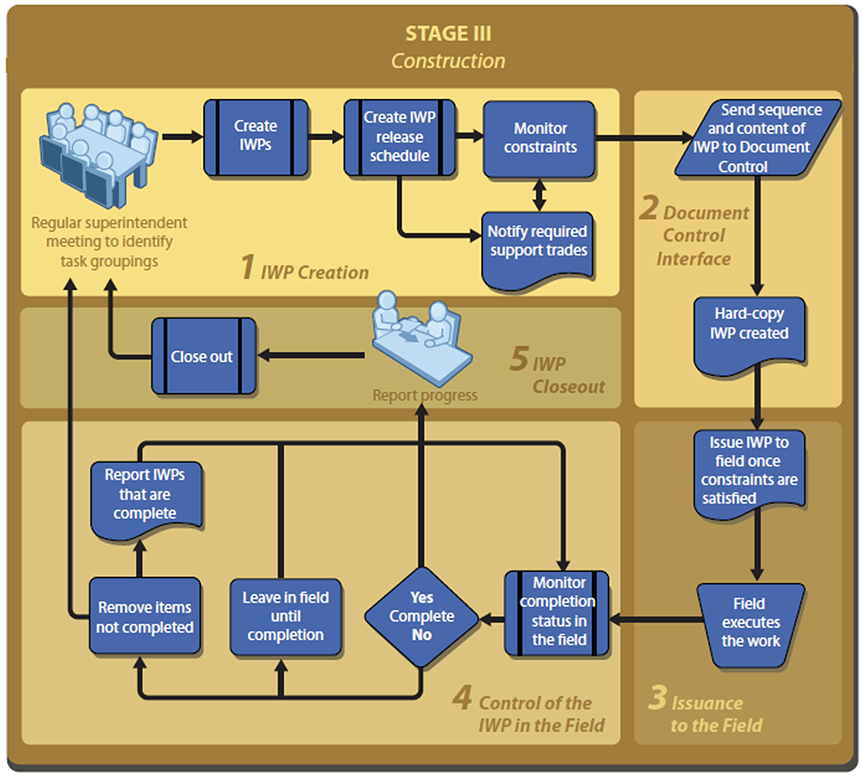
From: CII “Advanced Work Packaging: Design Workface Execution,” Implementation Resource 272-2 Version 3.1, Vol. 1 (October 2013)
3.2.3.1 Stage III – IWP Creation
Figure 6 shows the IWP Creation process. It is in this step where the individual IWP scopes are identified and the IWP starts the journey towards field issuance. Key coordination respective to the schedule and the monitoring of the constraints is necessary. If the identified constraints can be removed prior to the issuance to the field, the IWP then moves to the Document Control interface step.
Figure 6
IWP Life Cycle Flow Chart 1 – IWP Creation
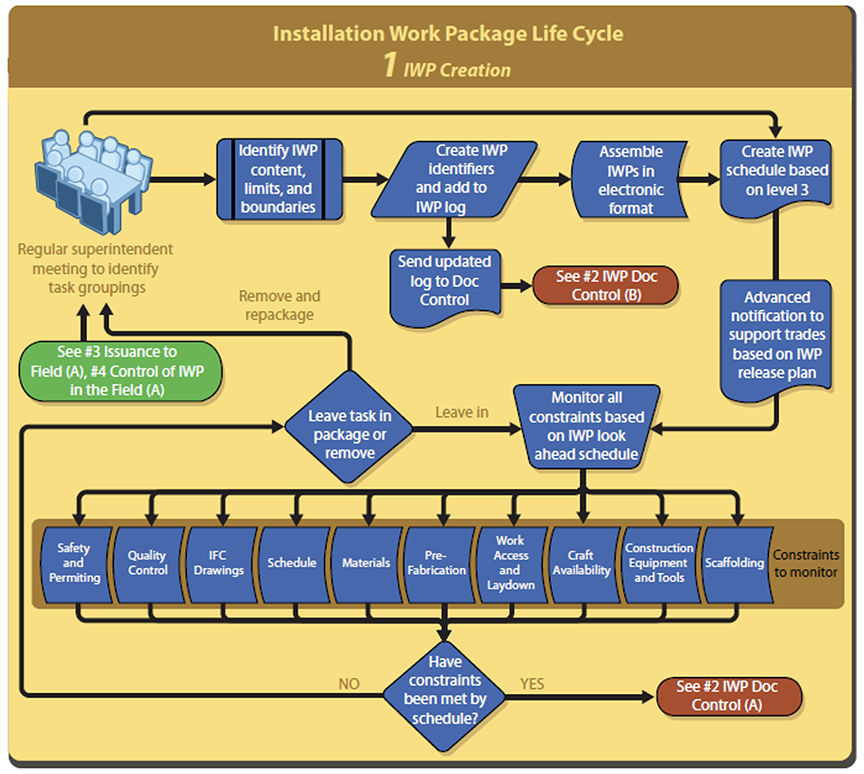
From: CII “Advanced Work Packaging: Design Workface Execution,” Implementation Resource 272-2 Version 3.1, Vol. 1 (October 2013)
3.2.3.2 Stage III – Document Control Interface
Figure 7 shows the Document Control Interface step. In this step, the IWP is checked to ensure that the appropriate approvals have been received and that the latest revisions of the various documents are included in the IWP. Once the IWP is logged and validated by the Document Control group to have all the necessary components and approvals, the IWP is released to the appropriate Workface Planner for the final validation.
Figure 7
IWP Life Cycle Flow Chart 2 – Document Control Interface
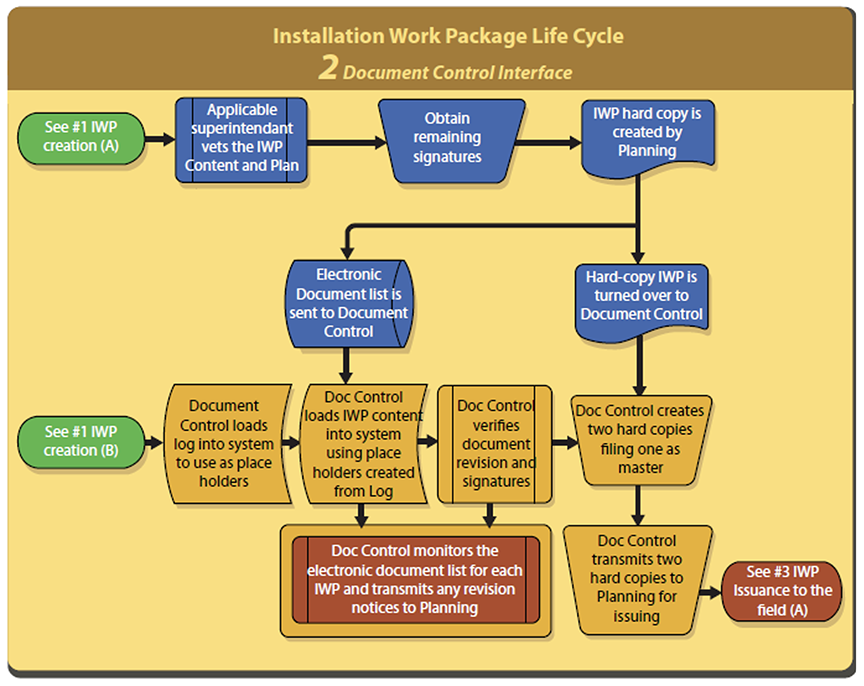
From: CII “Advanced Work Packaging: Design Workface Execution,” Implementation Resource 272-2 Version 3.1, Vol. 1 (October 2013)
3.2.3.3 Stage III – Issuance of IWP to the Field
In this step, the Workface Planner monitors and validates that all of the required constraints to execute the IWP have been removed. Once all the constraints have been removed, the IWP is sent to the appropriate field superintendent for field execution.
Figure 8
IWP Life Cycle Flow Chart 3 – Issuance to the Field
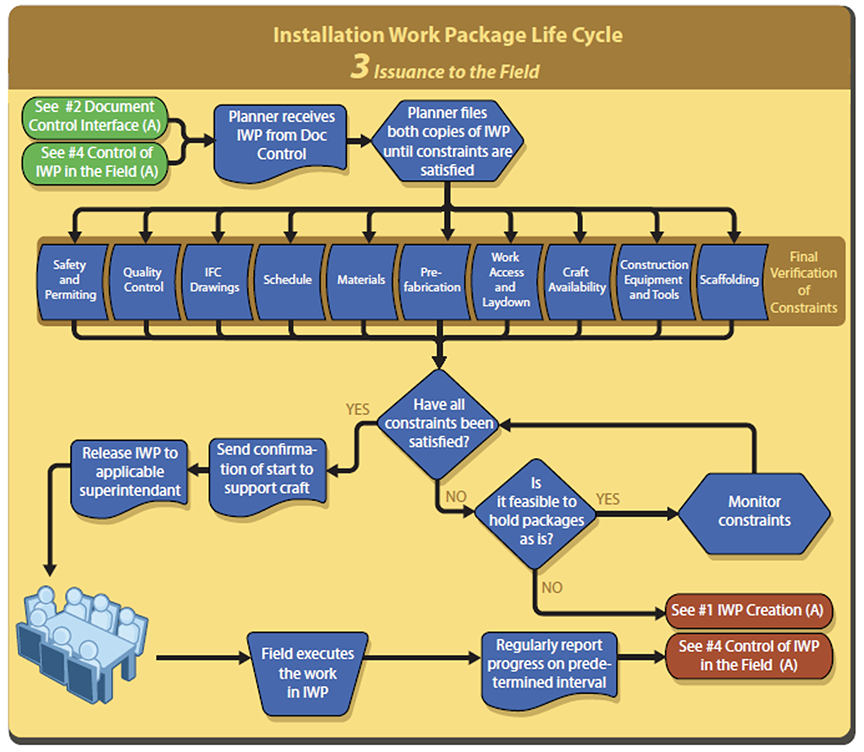
From: CII “Advanced Work Packaging: Design Workface Execution,” Implementation Resource 272-2 Version 3.1, Vol. 1 (October 2013)
3.2.3.4 Stage III – Control of the IWP in the Field
In this step, the IWP is monitored and reported on in the field to ensure that the IWP is completed. Alternatively, the IWP is recycled for completion at a more effective time.
Figure 9
IWP Life Cycle Flow Chart 4 – Control of IWP in the Field
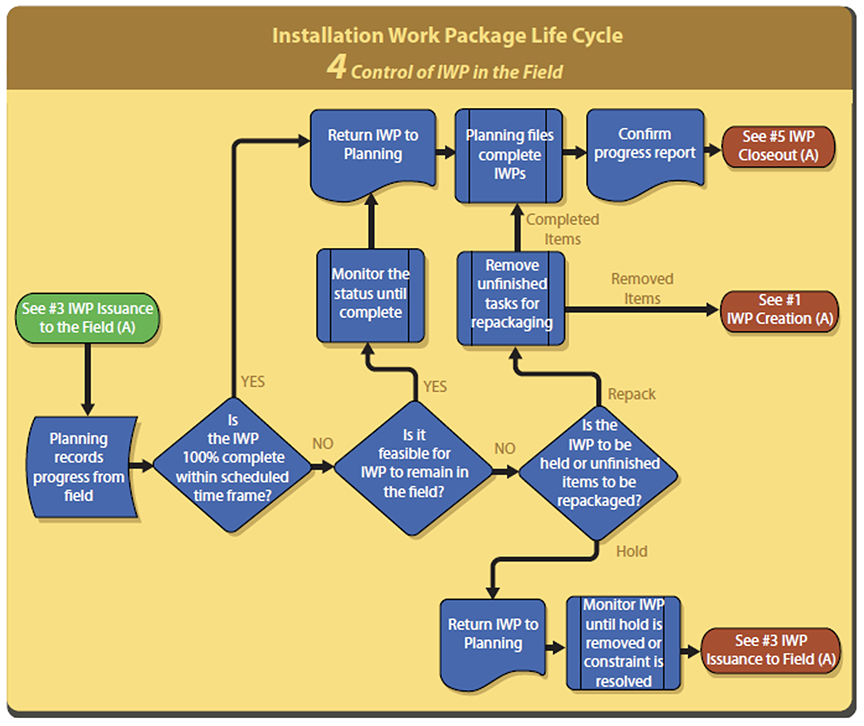
From: CII “Advanced Work Packaging: Design Workface Execution,” Implementation Resource 272-2 Version 3.1, Vol. 1 (October 2013)
3.2.3.5 Stage III – IWP Closeout
In this step, the IWP is progressed and it is confirmed that all the necessary elements to close out the IWP have been addressed and documented.
Figure 10
IWP Life Cycle Flow Chart 5 – IWP Closeout
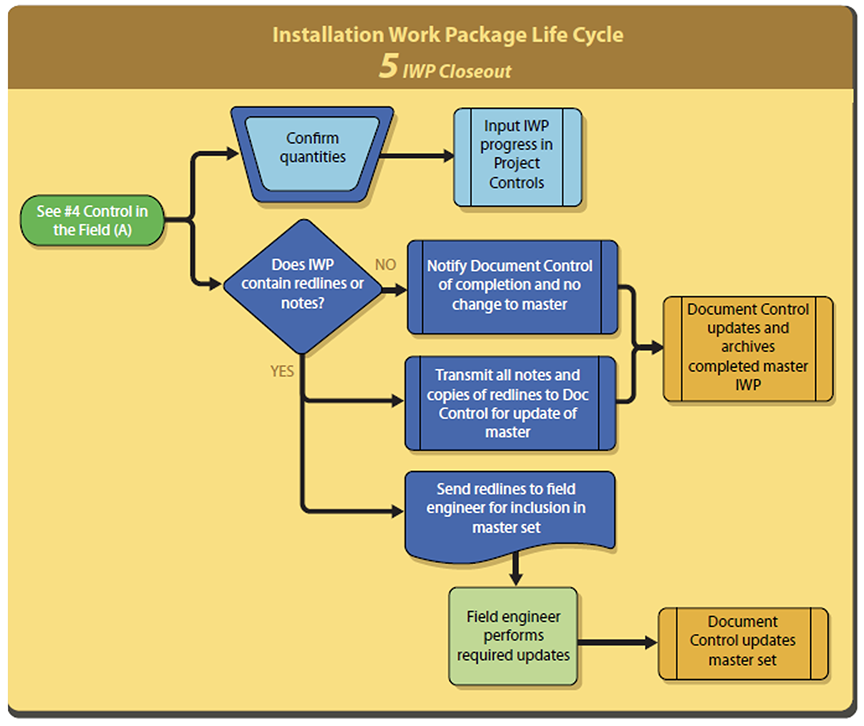
From: CII “Advanced Work Packaging: Design Workface Execution,” Implementation Resource 272-2 Version 3.1, Vol. 1 (October 2013)
When implementing AWP methodology, there must be an early, continuous, and deliberate approach in the planning and execution to address and mitigate the potential barriers to AWP. Some of the potential barriers that have been experienced are:
- Insufficient owner support of AWP;
- Insufficient development of a clear AWP implementation strategy;
- Insufficient detail in defining the contractual requirements of the AWP implementation;
- Lack of identifying the resources (and their roles and responsibilities) required for supporting AWP;
- Lack of experienced and knowledgeable resources in AWP implementation; and
- Lack of defining and providing the necessary information and project control systems for AWP.
To ensure successful implementation of AWP, it is recommended that an AWP assurance program be employed. The objective of the assurance program is to drive successful AWP implementation by ensuring the readiness and sustainability of AWP throughout the project. These AWP assurances can be easily integrated into a project’s overall quality assurance program. The AWP assurance reviews should be conducted proactively to identify and address potential problems. Some of the suggested assurance reviews are readiness reviews and interim progress reviews.
4. SUMMARY
As projects are becoming more complex, and with greater emphasis on project profitability and execution predictability, more owners are specifying that AWP be implemented on their EPC construction and fabrication projects. It is envisioned that AWP implementation will soon become the norm in EPC project execution. AWP implementation on EPC projects will grow in maturity. The technology, project management processes, resource skills, training, consulting and support services necessary to support AWP will grow and mature commensurately. This combination of maturity, further standardization and development in AWP processes and resources, and technology is expected to be a game changer in providing a stair step-performance improvement in overall project execution. Based upon initial results, the application and implementation of AWP principles on projects has proven to be successful and consistent. As evidence, the CII’s recognition of the AWP process as a CII Best Practice.
The AWP process will continue to be matured and improved upon by the owners, contractors, and service providers that implement AWP. The AWP process must supplement and align with good project management practices and craft labor productivity programs already established. AWP cannot be expected to achieve good results if there is a lack of the fundamental good project management practices.
This article presented a summary overview of the CII AWP process. There is a significant amount of additional detail information available for defining the AWP process and its implementation. Additionally, there is software available that readily supports AWP through to the development and control of IWPs. This Advanced Work Packaging software is strongly advocated to be utilized on larger projects.
The AWP process represents the next evolution in project management and in the successful planning and execution of construction and fabrication projects. For more information, details of CII’s Advanced Work Packaging, along with implementation resources can be found in CII’s RT 272 and RT 319 publications.
About the Author
Sean P. Pellegrino, P.E., is a Principal with Long International and has over 40 years of experience in all aspects of engineering, project management, project planning and execution, and project management consulting for onshore and offshore oil and gas projects. Mr. Pellegrino’s extensive and varied professional project experience in the oil and gas industry includes responsibilities for the full project life cycle. Mr. Pellegrino has supported, managed and consulted on some of the oil and gas industry’s largest, most complex projects. His responsibilities and experiences include the conceptual business case assessment to the planning, contract development and award, execution, administration, commissioning and startup and close out of projects. Mr. Pellegrino co-chaired the Construction Industry Institute (CII) Research Team 272 for Phase I and was a research team member for the Phase II initiative for the development and implementation of Advanced Work Packaging for construction. Mr. Pellegrino earned a B.S. in Mining Engineering from the University of Pittsburgh in 1981 and an M.S. in Engineering Management from the University of Houston in 1991. Mr. Pellegrino is based in the Houston, Texas area and can be contacted at spellegrino@long-intl.com and (832) 275-5811.
1 Research Team 272 Phase 1 was originally chartered in 2009 as Enhanced Work Packaging: Design through Workface Execution. The Construction Owners Association of Alberta (COAA) was a collaborative partner from the beginning. CII and COAA jointly chartered Phase II of the research in 2011. Two changes emerged: (i) the original name, “Enhanced Work Packaging,” was changed to “Advanced Work Packaging”; and (ii) in the context of Advanced Work Packaging, the COAA term “workface planning” was used specifically in the construction execution of the AWP process.
2 See Research Team 272, “Advanced Work Packaging: Design Workface Execution,” Implementation Resource 272-2, Version 3.1, Vol. 1 (October 2013) 7, pp. 13-44.
3 See Research Team 272, “Advanced Work Packaging: Design Workface Execution,” Research Summary 272‑1 Version 2.0, Vol. 1 (July 2013) 12, pp. 17-19.
4 Mr. Pellegrino co-chaired the CII Research Team 272 for Phase I and was a research team member for the Phase II initiative for the development and implementation of Advanced Work Packaging for construction.
5 See Research Team 272, “Advanced Work Packaging: Design Workface Execution,” Implementation Resource 272-2, Version 3.1, Vol. 1 (October 2013) 7, pp. 7.
6 See IPA Industry News (February 4, 2011), IPA Founder and CEO Edward Merrow’s appearance on the Oil & Gas Today Podcast, “The Boardroom.”
7 Id.
8 See IPA article (April 29, 2010), “IPA Finds That Most Site-Based Projects Fail to Meet Business Objectives,” (Online). Available: https://www.ipaglobal.com/news/article/ipa-finds-that-most-site-based-projects-fail-to-meet-business-objectives/ (January 2017)
9 See Productivity Enhancement Resources, Inc., Polaris Pilot Process Study, January-May, 2011. The Polaris Process is designed to maximize foreman availability in the field.
10 Workface Planning (WFP) is the term initially defined by the Construction Owners Association of Alberta (COAA). The initial WFP focus was on field installation of the work packs. The desire to improve the process led to efforts in the front end of projects and the designation of EWPs and CWPs. Earlier publications and currently some owners and contractors still refer to WFP as an overall term for AWP. The CII and COAA endorsed usage between AWP and WFP is shown in Figure 1.
11 See The Advanced Work Packaging Institute, “Advanced Work Packaging Complete Glossary” (2016).
Copyright © 2023 Long International, Inc.
ADDITIONAL RESOURCES

Articles
Articles by our engineering and construction claims experts cover topics ranging from acceleration to why claims occur.
MORE

Blog
Discover industry insights on construction disputes and claims, project management, risk analysis, and more.
MORE

Publications
We are committed to sharing industry knowledge through publication of our books and presentations.
MORE

